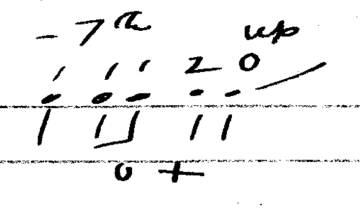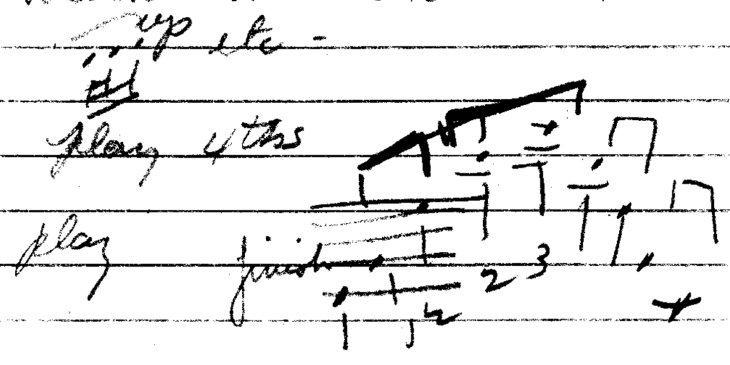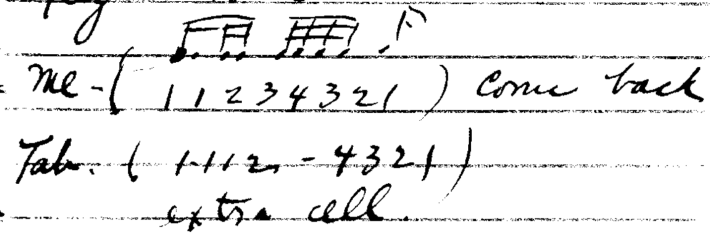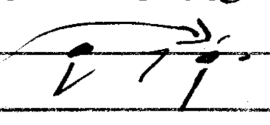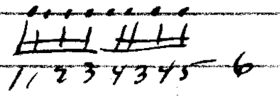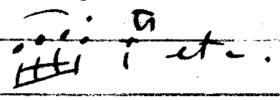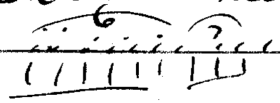Laila’s Private Lessons with Tabuteau 1945-46
Ludlow Building Studio
During this period Laila became second oboe in the National Symphony Orchestra.
She was granted a semester year of post-graduate status by Curtis.
The number of orchestral solos that Tabuteau is teaching is notable.
Pre-Lesson: October 4, 1945
Sing, get ideas, then try to meet your ideals. It must be that way in music as in all of life.
Practice loud and soft: leave space between them. Then soft and loud. Know what you are doing.
Play arpeggios with up diminuendo. Not too much reed on high notes.
Play the I and V chords in every key. Don’t blow, no wind; play like these are one note. Different tone qualities are generated from the embouchure: open and close it all the time. Be flexible.
Beethoven Seventh Symphony: 2nd Movement. Second oboe part:
Lesson 2: October 16, 1945
Barret Grand Studies 15 and 16: Practice these slowly and work for inflection.
Ferling Studies: Practice one of these slowly.
Lesson 3: November 3, 1945
With second octave F♯, add the B♭ key.
In order to avoid cracking the high D, play it with the right hand C♯ key (instead of the C key) and add fingers 2 and 3.
Barret Grand Study 15, lower voice: Barret is like a song. Sing each interval cantabile.
Ferling Etude 13, measure 11: In order to diminish G to C♯, push the reed in and pinch with the embouchure, and blow. Change the embouchure between notes, not ever on the note.
Barret Grand Study 16, measure 1: You must feel a difference in embouchure when playing C♯ to G♯. Regarding intervals, you must play everything in-between them. Strike a note on the continuity of the preceding note.
Tabuteau’s system is based on the laws of the universe, of the earth going around the sun, the revolutions of the earth…the circle.
Practice with intelligence and with the speed of the wind. Push and pull the reed in and out of the embouchure. Use more reed. Whistle and sing more. Have your lips firm on the teeth but not stretched. You must compensate for the shape of the mouth.
Lesson 4: November 17, 1945: an hour and fifteen minute lesson
Stay on this track.
von Weber Oberon Overture: 1-1-2-3-4 |4-3-1
Ferling Etude 15: Don’t force or blow. Make it all easy:
Ferling Etude 16: Transposed up to C minor. At the end: G-E♭ (F♯-D) is 3-1. Don’t blow, less wind.
Ferling Etude 17:
Measure 1: B♭ to F: don’t pull the reed out; use forked F. Press in and forward with the wind.
Measure 3: Play high D immediately after the F and do this in rhythm. Hold and whistle; don’t choke the tone; press with each hand to darken the tone. Play the cadenza in the character of the piece: Adagio. And do this in the same rhythmic relationship, not too fast. In playing the two-octave range C down to C, do not play loud on the low C. Then on the triplets, progress as follows: mi-sol-si, mi-sol-si, etc.
Measure 22: For intervals, namely E♭ to G, play all the notes in the interval. See how your embouchure is on each note, not the same. Then know what to do for the interval.
Ravel Daphnis et Chloe: Play this like an exercise, landing on the right note:
Always make it smooth, even your fortes.
Lesson 5: December 1, 1945: an hour and fifteen minute lesson
Play with your lower lip further under. Play on the tip of the reed and don’t force. Relax, don’t pinch the reed. Say O to produce a round, dark sound. Don’t play rough. Practice it all on pianissimo, but alive.
Ferling Etude 17:
Measure 6: Practice the turn on different degrees of the scale:
Measure 7: On the high C held before the cadenza, you can give your maximum; let it ring. Take the note and then open your embouchure. The vibrato is the intensity of the speed of the wind. The lips can be as open as possible. Take care of the wind pressure.
Measure 16: On the trill, don’t think of playing fast, but of lifting the trilling finger high. The trill must be measured using groups of six in strict rhythm. Otherwise there is no meaning to it.
Measure 19: Give a little inflection or impulse:
Measure 21: Scale the passage, practicing as follows:
5 must be higher on the circle, the furthest up. The 16th note must be exactly in place.
Ferling Etude 19:
Measure 9: Trill until the very end of the note.
Measure 12: Place the grace note on the beat; but place the weight on the B♭ which is the important note.
Measure 17: Scale the turn. More on the A.
Ferling Etude 20:
Measure 1: Rather than playing fast, find the spirit and form of each study. In this study, the only exception of long is found before a trill. Make that note short, and place the trill exactly on the beat. Trill twice if possible.
Measure 2: Don’t collapse.
Measure 34-36: Also, there must sometimes be some sensuality in music, not too much astronomy or calculation. It must be a little naughty or wicked, i.e at the end of this study.
Lesson 6: December 22, 1945: an hour and fifteen minute lesson
Hear the sound indicated by the notation in your head first, then adjust you embouchure to get it. Maybe a different position will be needed for each reed.
The secret of a good reed is to have it play the same pitch at piano as it does for forte. Scraping way back on the back of the reed does not cause it to flatten.
Ferling Etude 19:
Measures 2 and 28: Play the individual parts of a note, its anatomy.
Measure 9: Finish a trill in proportion to its speed. Measure, graduate the speed of the trill upwards, and play the nachschlag in relation to the speed of the trill.
Measures 36-37: Play 4-3-2-1 with the wind.
Regarding the tuning note A: You can have seven different A’s insofar as qualities, pitch, etc. are concerned. A can be played with the addition of the C key, D & E♭ key, or the B key. In slow parts never play a naked, exposed note with the basic keywork; cover it by putting down another key.
Embouchure: play more O than EE. Play flatter. Use more lower lip and more speed of the wind. Don’t pinch: the reed opening is small: look at it. If you choke it, how can you play? Use your nose, don’t blow with your embouchure too far up on the reed and, therefore, the oboe.
You must play like an egg on a stream of water in a shooting gallery. The water pressure pushes the egg up and down. You must blow like that. Right now you are not using your wind.
Tchaikovsky Symphony 4, 2nd movement: at the end of the oboe solo play the B♭ with the E♭ key down in order to flatten it, so you can squeeze for piano.
Lesson 7: December 29, 1945: a 45-minute lesson
Play the oboe like a violin. Feel the bow on the string, then give.
Ferling Etude 22, Measure 9: Progress in the piano section.
Use your jaw and feel a change of position by changing your whole jaw forward and back. Use more wind and pinch to get to a lower note. Let the wind travel. Play free: take a little phrase and play with it.
Your embouchure must squeeze in and out between notes all the time.
Lesson 8: January 19, 1946: a one-hour lesson
Brod Etude 11: Don’t force going up to a high note. Play pianissimo with intensity.
Brod Etude 12: Make the accents definite in the middle section at Measure 16. Calculate your embouchure position in order to obtain the low C at the end.
Schumann Piano Concerto: In the octave leap from A to A, use the harmonic A for the octave.
Lesson 9: February, 9 1946: a one-hour lesson
A big tone must be more condensed. Blow more towards the nose, at your glasses. Practice more on the internal cells [subdivision]:
Do not play shrill, cover more.
Brod Etude 12, Measure 23: For G to high E♭: push your lower jaw forward. Use less wind, more air speed; this is accomplished by forcing the air through a narrower space. Don’t let the sound get away from you in a wild manner.
Ferling Etude 23:
Measure 1: G♯ must be long.
Measure 4: Take hold of the sound like a violinist with his bow. Change bowings and play C♯ on the length of the bow. On the down, D must be higher than C♯.
Measure 23: Hold C♯ pianissimo and up.
Measure 31: The 16ths are too active. They must be level, but with inflections.
Measures 37-38: You must turn and go higher on the 16ths.
Measures 38-39: Play the progression 1-1-2-2-1 as if each part of the dotted 16th to 32nd were separated.
Ferling Etude 24: Let the rhythm of it carry you.
Ferling Etude 25:
Measure 1: Stop after the dotted eighth, and then play up on the 16th.
Measure 30: F to E♭: You must get that turn in your long note: make the circle.
Lesson 10: March 9, 1946: a one-hour lesson
Ferling Etude 25:
Measures 1-2: Play these two measures as one line, one wind.
Measure 2-3: Play as follows:
Measure 3: On re [D], keep the note traveling as you would throw a ball. The sol [G] must be higher on the turn than the re. It keeps going; the higher you go, the more you will be able to come down.
Measure 6: Play the group of nine as follows, graded in length:
If understood, there is enough in the first two measures of this study to work on for a whole lifetime
Ferling Etude 26: Play a free, with short staccato. Don’t have a choked, shrill tone. Have a more flexible embouchure. As an exercise, practice high B♭ down to low A♭, high C down to low G, etc.
Lesson 11: March 30, 1946: a two-hour lesson
Play your orchestral solos out and give the utmost. Above all, sing and play them as you would sing them. Of course, you want to play with your embouchure and the oboe. But it must be the wind which does the work.
Brahms Symphony 1:
1st Movement: Like one line. Note the question and answer.
2nd Movement, 1st solo: Give your all on the high B. Wait before E at the end and play the remaining 8th notes a little lighter.
2nd Movement, 2nd Solo: Resolve on a full high C♯. Under the clarinet note play: 5-4, 4-3, 3-2.
3rd Movement: Play wildly, then there is a little march.
4th Movement: At measure 132 play the musical sense regardless of the slur markings. Play full on la-do, measures 135-136.
Prokofiev Peter and the Wolf: Play the solo grotesque and exaggerated as much as possible. Emphasize the quacks, the short grace notes.
Lesson 12: May 1946
You must understand the circle, particularly the turning point: push and pull. Take note of the speed of the air and play on O. Your embouchure should be round, not tight and pinched. Increase the speed of the air for high notes.

